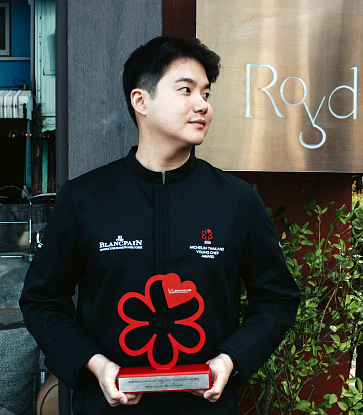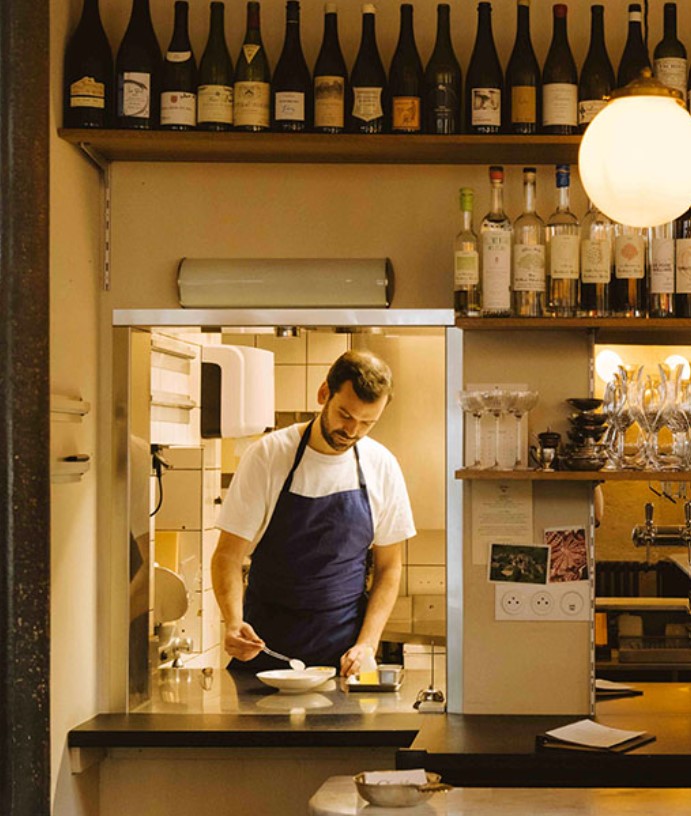Located rather close to Bangkok, Nakhon Pathom is a charming little city with a distinctive culinary culture that outsiders wouldn’t know much about. Visitors may hop around trendy cafes on the riverbank and have their mind set on the khao muu daeng (barbecue pork on rice), Nakhon Pathom’s signature dish.
But very few would know that the city was among the first in Thailand that offered night market shopping, an activity perceived by locals as inventive some 40 to 50 years back. During that time, it was common to cook your own dinner and eat it at home with your family. Night markets were the new, exciting places to hang out especially in Nakhon Sawan, Hua Hin, and Nakhon Pathom, which successfully attracted travellers heading south.
And who could guide you through the Nakhon Pathom night market better than someone who grew up eating in and walking around it? This time we have Chef Thanintorn “Noom” Chantharawan of the One-MICHELIN-Starred Chim By Siam Wisdom to show us around, and share his insights about decades-old eateries at the one-and-only Phra Pathom Chedi night market.

“Literally, I lived next door to the night market. After school I would stop by looking for something to eat. The choice was endless. Traders would park their small trucks or pushcarts in line in front of the stupa just like this. Many shops were handed over from parents to their children. Unlike other night markets, here you wouldn’t see many outside sellers. Most are locals who have been doing their trades for decades. What I also like about this market is that it’s really wallet-friendly. For a few hundred baht, you’d be well fed. Savouries. Desserts. Drinks. You name it.”
Chef Chantharawan took us back in time to his wonderful childhood, when he first acquired a culinary inspiration here at this market. This is where he was introduced to the authentic flavours of several dishes. He pointed at the khanom bueng (Thai style crepes), which is still made the traditional way here with absolutely no butter and cream, as you would expect to find in its ‘modern’ version. The crispy crepes are thinly coated with irresistible palm sugar and drizzled over with the just-right seasoned shrimp and aromatic roasted peanuts. You can also order the sweet type and instead the crepes are topped with the glossy, homemade ‘golden thread’ or foi thong.

The shop owner couldn’t tell exactly when the khanom bueng stalls at this market had started serving the delicious little morsels. “I can’t really remember. But I started helping my mom when I was nine and here I am still selling it in my mid forties. We still rely on the very same recipe. We make our own flour mixture using a stone mill to ensure the crepes are thin and crispy. Also, our foi thong is homemade. Every process is time-consuming so it takes a whole day to prep, and we come out to sell in the evening.” He’s the only shop selling khanom bueng boran (old-school crepes) in the market now. Warning: the queue is usually long and the owner really takes the time to adjust the heat to nurture his little crepes. It’s best that you head here first to make the order and stop by later to pick it up.
“Nakhon Pathom has a rich food culture. We have quality ingredients and great food diversity. These traits have definitely influenced me as a chef and diner.”

Start off at a shop called yam yod laem for a variety of inexpensive and addictively delicious yam (Thai spicy salad). The beautifully dressed lady owner would be there to greet her customers daily. Not so far from her shop is a beef noodle soup stall. There are beef balls, sliced beef, and overnight-braised beef available. The highlight is definitely the dry ‘no soup’ version as the seasoning is perfect with a nice aroma of fried garlic on top. The Thai chef revealed he’s been a regular customer here since he was young. And every time he would order the same thing, kao lao luk chin nuea, or beef balls in savory soup often served with steamed rice.
For fish lovers, find the decades-old khao tom pla (boiled rice with fish) shop where fish balls are freshly made in the back. If you still crave seafood, visit the hoi tod nai pom shop where you’ll find crisp-fried battered mussels made using a classic recipe handed down for generations.

Since there’s always room for dessert, we followed the chef to an ice cream stall, and soon realised what attracts the customers is not the ice cream alone, but also the exciting ‘flying ice cream’ show. Opposite to the ice cream shop is the sakoo sai moo (sago dumplings with pork) stall. The sago is kept the traditional way in a clay pot to preserve the beautiful aroma. Another long-standing vendor and Chantharawan's childhood favourite nearby is the bua loi Techew (sweet Techew dumplings in coconut milk). Don’t be discouraged by the long queue - it’s worth it. The dough is nice and light with a pleasantly chewy texture. The future chef also loved coming here as a young boy.

“Looking back, growing up in the city with great choices of quality ingredients and markets full of local delicacies really shaped my culinary experiences,” Chef Chantharawan admitted as he proceeded along in the bustling market. “I lived very close to the night market. Every evening I walked here and saw the great variety of food available. I saw how people properly cleaned pork entrails. How quality fish balls are produced. How traditional Thai desserts are made without the need for western ingredients like butter and cream.”

The Phra Pathom Chedi is Nakhon Pathom’s significant place of worship, while the market in front of it is the bloodline of the local economy and culinary wellbeing. This charming little city is only an hour’s drive from Bangkok.
“For a little over one hundred Baht, you can have it all here. From appetiser, main course, desserts, to hot and cold drinks.” The chef, who leads a team of cooks in a fine dining kitchen in the heart of Bangkok, said with a smile. Although eating in courses is not a custom on the Thai table, that's one good way to explain how affordable this market is.
Feel like hitting the road already? We’re sure you won’t be disappointed.
Hero photo: © Anuwat Senivansa Na Ayudhya / MICHELIN Guide Thailand





















